by Jen Moss, originally posted here: Mountain Parent
Our story pivots around one precise moment.
A phone call one afternoon in May 2016 almost four years ago.
Every life event before and every moment since is redefined now in relation to the information we received that afternoon. The rest of that particular day is a blur, and yet some details are crystalline in my memory.
We were at Sopris Park celebrating our then five-year-old son Jax’s last day of preschool. It was a beautiful, warm spring day, and everyone was enjoying being outside. My mother Claudette Collier, who was visiting, walked our almost-two-year-old daughter Addy back to our house near the park, so I could focus on Jax. The leap then between pre-k and kinder felt exciting, even monumental.
Around 3:00 PM, my mother hurried back out to the park. She said she’d stay with the kids. I needed to go talk with my husband Brent. I will always remember the looks on my friends’ faces as everything stopped and I raced home.
We’d been seeking answers about our daughter Addy for seven months. Brent told me what the doctor said: “We think your daughter has 4H Syndrome Leukodystrophy.”
I heard the words. I saw Brent’s notes scribbled on a piece of paper… I studied them in disbelief and sobbed for what seemed like hours.
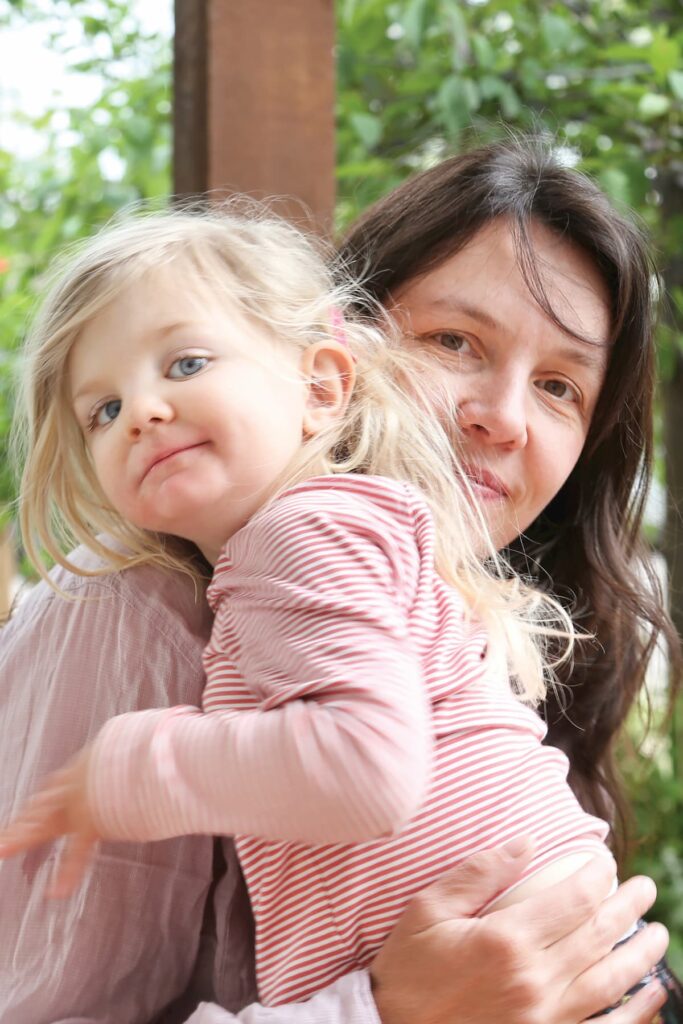
B.C. Before Children
The story of how we arrived at this moment starts like that of many transplants from elsewhere in the U.S. who move to our Valley, who meet here, who fall in love with each other and with this place. I set out for Colorado in the fall of 1997. I packed up my red Saab and my chocolate lab Dakota and we hit the road with the dream of living in the mountains. I had a great life growing up in Chicago and spending weekends with family at our lake house nearby in Wisconsin. I had graduated from Bradley University in Peoria, IL, and for two years, I felt fulfilled at a great job working as a graphic designer in the city. However, I had deep ties to the Aspen area, and much like the lake house, Colorado has always held a special place in my heart. So I left one place I loved for another.
Brent and I met shortly after I moved to Carbondale. A fellow Midwesterner himself, we instantly connected. We worked hard, played hard and dated eight years while renovating an 1886 home. We married in 2005 then decided to do it again. This time – a bigger home with room for kids, a place where family can visit.
Our Baby Boy
In July 2011, our son Jax was born and my motherly instincts kicked in, just like everyone predicted, the moment I gave birth. We named him after my grandfather whom we credit with getting me here – Grandpa Leon started skiing Ajax in 1955 and if not for his love of our Valley, I may have never started visiting here at age four. So Leon Jax just felt right. Like many new parents, we were scared to bring this tiny human home from the hospital, but everything fell into place.
(What a gift!) Jax has been a strong kid from the get-go – an early walker, riding a strider at 14 months, skiing at age 2½ and ripping on a pedal bike by age 3. Mothers used to flinch when they watched Jax whiz around the playground, but that was Jax, and even though he made me nervous too, we let him rip. I always laugh and say “Jax: scaring moms on the playground since 2012.”
Waldkinder Adventure School proved to be a good fit for Jax and for us. Karen Grey’s fun outdoor preschool allowed him to explore his boundaries and taught us to let him do so. It will always be a part of him and helped shape him into a kind, smart, loving child – a perfect combination of traits for the big brother he would become at age three.
A Little Sister
We named our second child Adele after my great grandmother, who lived life to its fullest, whom we considered “way before her time.” Into fitness and healthy eating her whole life, she got the kids at the lake doing calisthenics every day before anyone knew what calisthenics were. She attended beauty school after raising four boys, so she could provide orphans with haircuts, helping them feel good about themselves. Grandma drove before it was popular for women to drive; she bought the car she wanted, and the tractor she wanted and enjoyed her freedom. She never stopped reading and eating healthily and lived to 99. Our daughter’s drive, her attitude, and she will certainly follow in Great Grandma Adele’s footsteps. We call her Addy.
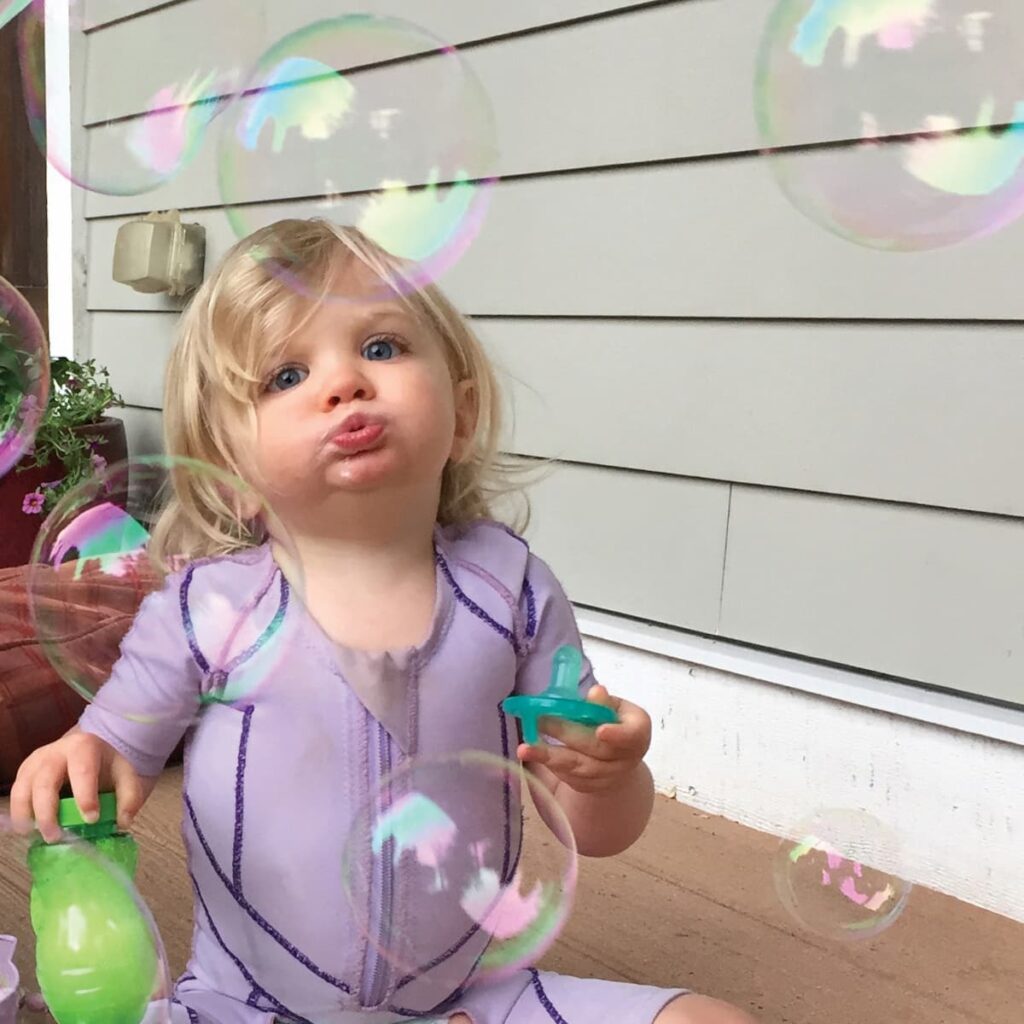
Milestones
When you take your second child to their well-check appointments and bring up your concerns, your doctor will likely tell you to give it time, and not to compare the siblings. Yet at 15 months, Addy was not pulling herself up to standing, nor walking or standing without support. She had not cut her first tooth. She made none of the pre-talking sounds you expect by age one.
Friends tried to diagnose her, and although appreciated, it was frustrating. We had to start somewhere, so we started with a pediatric dentist and mouth x-rays to learn that Addy’s teeth were all present. They simply hadn’t come through yet. Next, we sought help from Dr. Ellen Brooks to understand the developmental delays we were seeing. She gave Addy a thorough examination and a micro-array genetic test, a basic screen to identify or rule out certain conditions. We waited for the test results.
In the Meantime
Dr. Brooks suggested that we contact Mountain Valley Developmental Services’ Early Intervention team. We immediately completed the paperwork and started speech, physical, and occupational therapies. Thankfully our support team worked at our home. Addy needed to get to know three different specialists working with three different treatment modalities, for three scheduled appointments each week, so being at home made a big difference. Consider the time and work this is for an adult, and then think of a 1½-year-old having the patience to sit and learn and be watched.
Through the therapists, I learned ways to help Addy cope with day-to-day challenges. For example, I learned how to support Addy’s positioning, so she could be more stable while standing. We worked together on Addy’s eating and swallowing, using straws to help strengthen the muscles in her mouth. One of the best ideas came in helping to minimize Addy’s frustration when trying to communicate. I made laminated signs of images, such as our dog Oly, Addy’s stroller, our house, swings at the park and even our bottle of almond milk – and these flashcards gave us visual cues that helped Addy show us what she wanted.
We spent seven months investigating Addy’s condition. Genetic tests proved inconclusive, and each little bit of therapy found us asking “what’s next?” Addy was improving slowly but we needed answers, and the paperwork started stacking up. Appointments with pediatricians, specialists, PT, OT and Speech therapy took every bit of our time, while we were still trying to work, raise our children and be good parents.
Finally, a Diagnosis
At age 22 months, Addy underwent an MRI at Denver Children’s Hospital. This meant sedating her, which terrified us. We kissed her and held her hand while she was put to sleep. We waited forty-five minutes until they came to get us as she was starting to wake up. Then, we waited six long days over Memorial Day weekend for Addy’s MRI results. The answer finally came with the fateful phone call when we first heard of 4H Syndrome Leukodystrophy. We immediately started gathering information. Leukodystrophy is so rare that learning about it proved challenging. The specialists at Denver Children’s Hospital had never heard of 4H Syndrome but suggested a single gene test that confirmed the diagnosis later that summer.
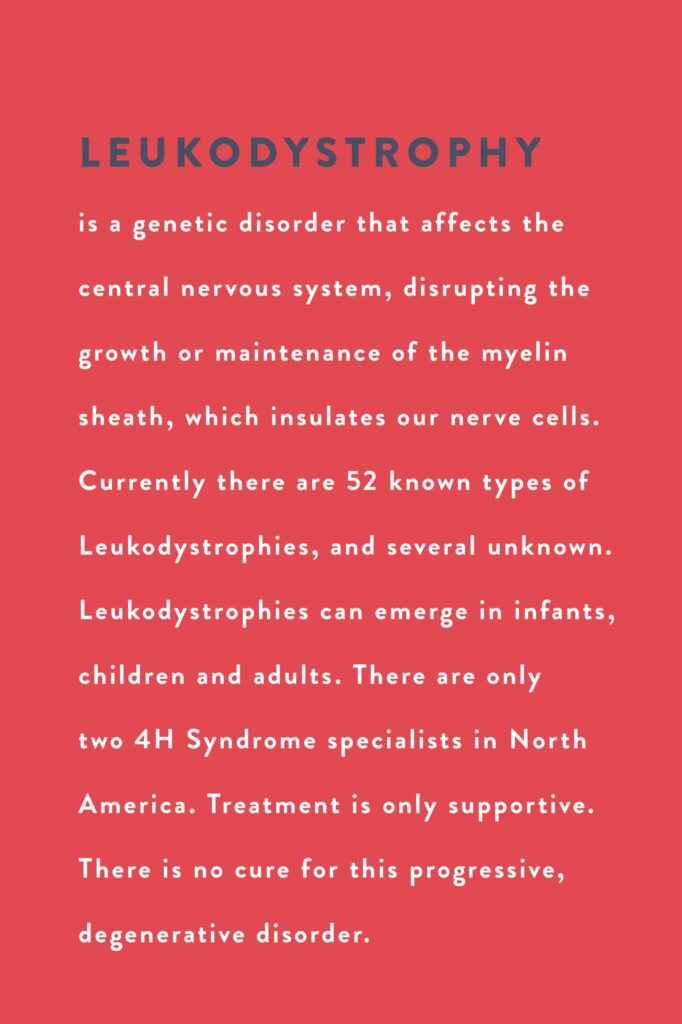
Finding Answers, Connection, and Experts
My mom and Brent’s parents, Lynn and Gary Moss scoured the internet for information and found the three foremost experts in the United States. They started calling and emailing them right away. All responded immediately and their sensitivity to our situation was amazing. I also reached out to a client and friend who directed us to CHOP – the Children’s Hospital of Philadelphia – with a center dedicated to all Leukodystrophies.
With the whole family quickly researching and reaching out, we learned of a United Leukodystrophy Foundation (ULF) conference in Omaha, Nebraska at the end of June, just weeks away. The diagnosis was not confirmed by any Leukodystrophy experts at the time of the conference, but our parents, Brent, and Addy attended anyway. I wasn’t ready to face the realities yet so I stayed back to be with Jax as someone usually does. We try not to bring him to Addy’s appointments especially if we don’t have to. It was helpful for Brent to meet other families dealing with Leukodystrophy. They also met experts who were able to observe Addy, and “unofficially” review her MRI and genetic test results, and confirmed that “yes, she does have 4H.”
The annual ULF conference has become an important component in keeping us updated with advancements and changes, and in connecting us with other 4H families. So our parents make it a point to attend each year. At ULF during the summer of 2018, we visited with one of only two 4H experts in North America. It was wonderful to meet her and her team in person, and have her see Addy after nearly 2 years of long-distance treatment.
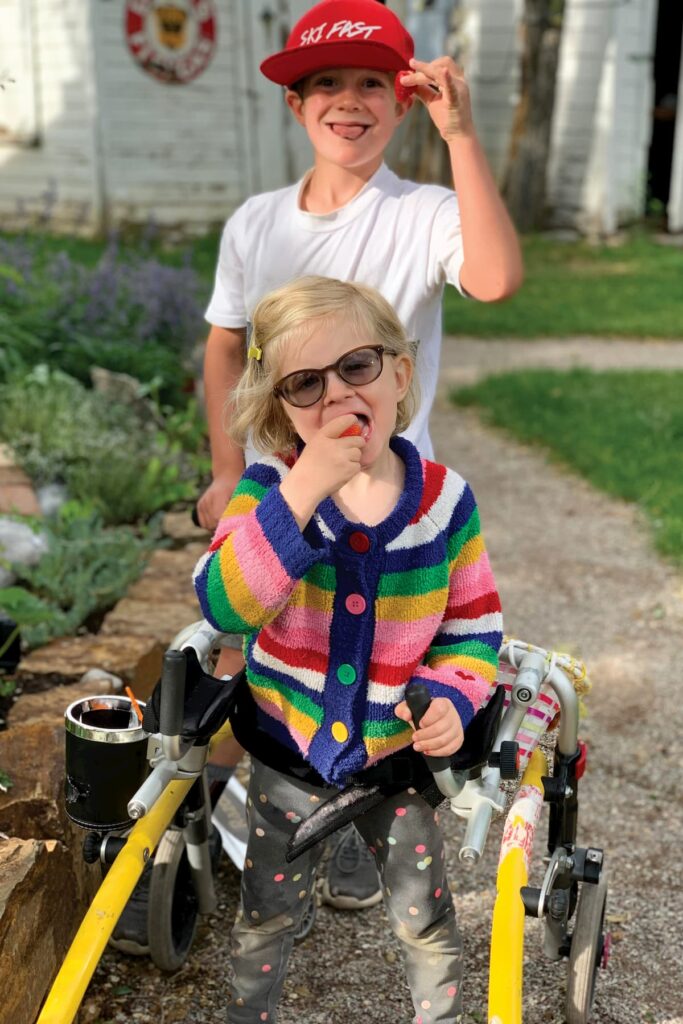
Becoming Fluent in Leukodystrophy
Now I know how to talk about Addy’s condition. Leuko-dystrophies make up a group of genetic disorders that affect the central nervous system, disrupting the growth or maintenance of the myelin sheath, which insulates our nerve cells. Currently, there are 52 known types of Leukodystrophies and several unknown. Leukodystrophies can emerge in infants, children, and adults. There is no cure for this progressive, degenerative disorder. Treatment is only supportive.
Addy’s specific type of Leukodystrophy is 4H Syndrome, also known as POLR3-Related Leukodystrophy. 4H is short for hypomyelination (slow formation of myelin in the brain), hypogonadotropic hypogonadism (hormone deficiency) and hypodontia (slow or lack of tooth eruption). People with 4H suffer from motor problems, resulting in ataxia and loss of or inability to walk. They often develop difficulties swallowing, which leads to problems with eating and breathing.
Staying Well
One of the critical issues with this condition is that Addy’s body cannot handle sickness, broken bones, or any serious injury. She has no reserves to recover from illness, so a simple cold that you can recover from in a week is not simple in our household. It can take Addy a month to get her strength back from any “minor” illness. This is terrifying for me and hard for others to understand. Every single time someone enters our home, we ask them to wash their hands. It doesn’t matter if they “just washed.” I don’t take Addy to the grocery store. We skip a lot of birthday parties.
Last Christmas, Addy contracted RSV and pneumonia. She was hospitalized, hooked up to tubes, breathing devices, IV fluids and antibiotics. My sister, Beth Walker, flew in immediately from Florida to help take care of Jax so he didn’t have to be at the hospital every moment. He was so scared for his little sister. We all were.
For weeks after getting out of the hospital, Addy spent 20 minutes 3x per day wearing a chest therapy vest that shook her whole upper body and kept her lungs clear of mucus. Addy was not allowed to go to her preschool or be out of the house for more than a month.
Paperwork Hell
Filling out forms, keeping documentation, talking and meeting with different agencies, navigating the convoluted State and Federal assistance programs – this is a full time job. For oneagency, I had to list every item of care I give to Addy and how many minutes each item takes each day. Here’s an example, breakfast time. Addy needs to sit in her highchair or be strapped into a booster seat. How long does that take? Since she can’t climb up on her own, it’s probably a 3-4 minute process. Then I prepare and cut up the food so she won’t choke on it, and get the correct utensils, cup with a straw and so on. After years of OT, she can now feed herself many things, but she cannot be left alone when eating, because, with 4H Syndrome, the facial and throat muscles are affected, so swallowing at any time can be a hazard. There’s the fact that simply holding food on her spoon is hard for her, as is keeping her plate on the table. She can clean herself up after breakfast, but giving her the materials she needs to do this takes time. The agency needed me to account for every minute. Just to name what we do on a daily basis, and to stop and think about how much time each thing takes – this takes a lot of time and energy. I need to hire a sitter just so I can handle the paperwork, and the constancy of it can be overwhelming.
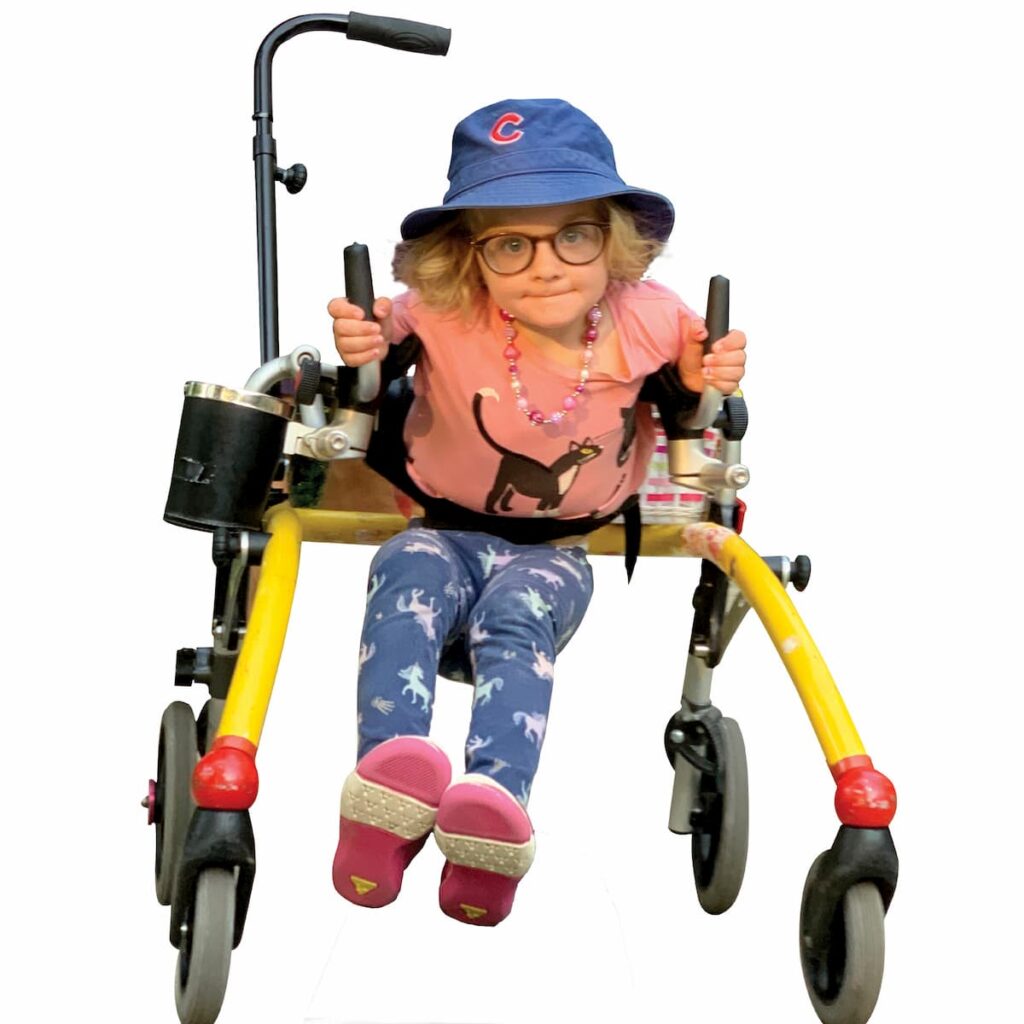
Superwoman wears arm cuffs,
and our Superhero wears a purple power suit.
As soon as we received Addy’s diagnosis, Francie Powell, our physical therapist at Valley View Hospital knew exactly what gear we needed and helped us procure it. Then, we embraced our new lifestyle. We test-drove seven different over-sized vehicles to find the best way to haul everything. Just to leave the house, it takes about 60+ pounds of gear, special food preparation, special cups and utensils, and of course 30+ pounds of a little girl. I recognized that I needed to strengthen my body in targeted ways so that I could carry everything without injury. So I reached out to Karen Bradshaw at Rising Crane Training Center. Now I attend a semi-private women’s class once a week, where Karen helps me train my arms, back, legs, abs – parts of my body that get maxed managing the gear. We’ll do anything we can to help enable Addy to get out and explore the world.
A Superhero Suit: Imagine getting a two-year-old to lie still on an examination table while 40 points of measurement are first marked on her body, then recorded, centimeter-by-centimeter. This is the first step of making Addy’s custom “Superhero Suit,” as we call it. We are now on our third suit. It’s called a Dynamic Movement Orthosis (DMO), this looks like a wet suit and needs to be worn all day except when Addy is sleeping. It provides her with support where her muscles are not strong. It also helps work out weaker areas of her body to make her stronger and more sturdy.
The Crocodile Walker: Addy has never been able to stand or walk independently. She uses a pediatric walker called The Crocodile, made by a company called R82, which has hip support and a seatbelt to keep her in place as she gets around. From the moment we got both her glasses and her walker – which happened around the same time – a whole new world opened up. Even with her mobility challenges, Addy loves to move. However, accessibility can be a challenge when pathways are not wide enough for Addy’s walker. My vision is to help create more places at our local parks and school playgrounds where Addy can get around independently to play and explore.
Upsee: This helpful piece of gear came to us two years ago through Amanda Boxtel of the Bridging Bionics Foundation. We met Amanda at the 2017 Fall Fest in Snowmass Village, where she gave a demonstration of her Exoskeleton, a device she uses to walk. When Amanda saw Addy, she stopped us and asked for her story. The Upsee is a vest that Addy wears whenever we are in a place where the terrain makes using the walker too hard. Addy wears the vest which attaches to a waistband worn by an adult who can then help Addy walk without the strain of trying to support her by bending over to hold her hands.
Galileo Vibration Therapy: After becoming acquainted with Bridging Bionics, we started working once per week with Maria Grufstedt, PT at The Snowmass Club. The Galileo Vibration Therapy is a box that Addy stands on to help activate her core while building balance. This strengthens the connections between Addy’s brain and her body, increasing neuroplasticity. This therapy has also helped Addy gain strength and confidence when standing and walking.
ADDY’S OASIS: Creating Accessibility
Addy is happiest when she’s outside, playing games, or chasing her brother. But often, playgrounds and other kid-friendly spaces are not accessible with the Crocodile. Our community rallied around us to help manifest an idea I had shortly after Addy’s diagnosis – to create “Addy’s Oasis.” This is an outdoor adventure area in our yard where Addy is safe, where every aspect is conducive to her needs. I imagined creating pathways, so Addy could navigate the yard with her walker, completely independent of our help.
My brother, Brian Collier, seized the opportunity to help us through the Polar Plunge fundraiser at a beach along the shores of Lake Michigan in Chicago. Anyone can participate in the plunge to raise money for different causes. Brian and my Uncle Danny Deasy jumped into freezing Lake Michigan and a huge group of family and friends came to support them and we celebrated with a party afterward.
In addition to the amazing individual efforts from friends and community members, two local businesses stepped up to help with things we could have never done without them. Todd Merriam and his team from Aspen Valley Landscaping started the installation process with their equipment and teamwork. Jake Boyles and the crew at Crystal River Spas helped make one of our most cherished activities come to fruition with a hot tub that they installed and continue to service for us. Start to finish, the project took six weeks and now our yard is easily navigable for Addy. She can do things other kids do, while utilizing the medical devices she requires, like her walker. Addy now has a therapeutically supportive haven to play independently with her friends and to grow and nurture her love of the outdoors.
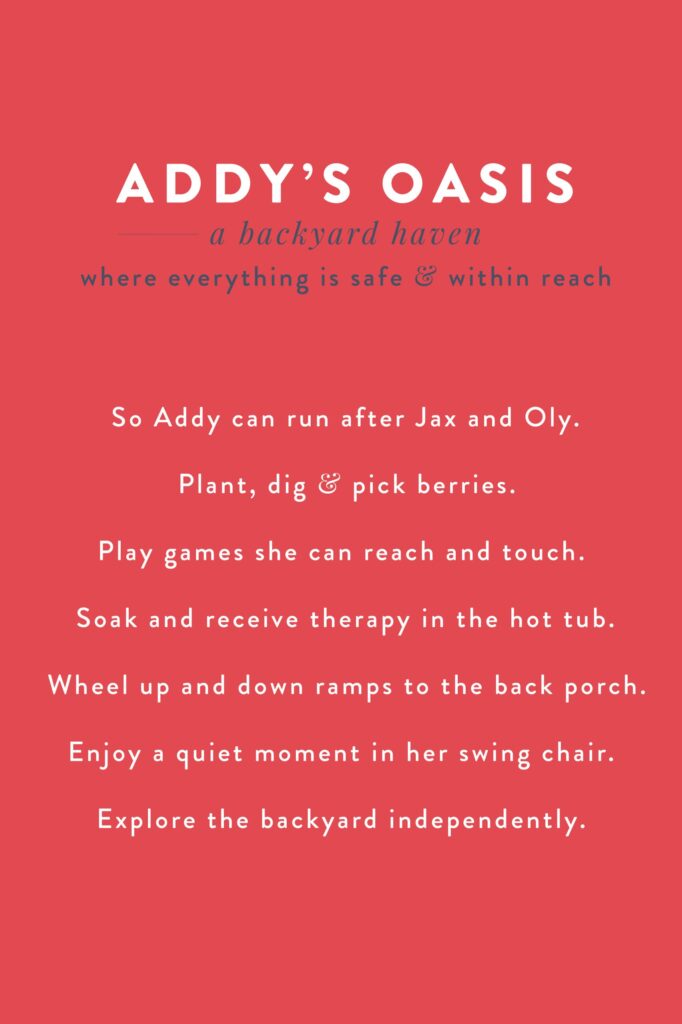
Making Friends
Addy loves to be around other children. But sometimes, meeting new people can be awkward. I jump in and encourage people not to be afraid or intimidated by her or her walker. When we are out some people stare with curiosity so I politely introduce them to Addy and tell them her sign language name to break the ice. If you’re ever in doubt, just smile, look her in the eyes, and say “Hello.” She appreciates this just like everyone does. Just know that Addy tends to get overwhelmed easily and it can get hectic for us in a hurry – so if we scoot away, don’t take it personally. We’ll try to play again soon.
The Little General
Addy’s nickname is the “Little General” because she can direct anyone with her sweet “come here” gesture. Her sparkling blue eyes are so expressive that sometimes she doesn’t need words to show you how she feels. However, this gift cannot fully compensate for the fact that Addy has never talked. She communicates mostly with sign language and gestures. We realized early on that Addy was gesturing to communicate, effectively creating her own sign language. So we started to use YouTube and American Sign Language (ASL) apps to learn more standard sign language so we could actively teach her to communicate in ways that other people can understand.
Two years ago, the speech team at Children’s Hospital assessed Addy’s language and communication. Addy sampled four devices to see which one worked best for her. She now uses an iPad with TouchChat software to help her communicate, though her preference continues to be signing.
While we were at Powers Lake in Wisconsin during the summer of 2018, I found an amazing caregiver, Michelle Clark, who lived in the next lake town over. She teaches sign language at a local school for the deaf. Addy enjoyed Michelle’s company and adjusted to the new sign language immediately. We brought 40 new signs home with us that summer when we returned to Carbondale!
After seeing how much Addy benefited through her relationship with Michelle, I began to spread the word around my Carbondale circle in search of another angel caregiver, and we found Ali Wade. We call her “Miss Ali” and she has become Addy’s friend, caregiver, and teacher. To have found two people whom I trust completely to take care of Addy is a blessing.
Going to School
When Addy turned three, she aged out of MVDS Early Intervention services, so she enrolled in Crystal River Elementary School’s preschool two-half days a week to see how she liked it and to receive the necessary therapies through the public school environment and its the Individual Education Plan (IEP) process. This was a wonderful opportunity for Addy and we saw how much she grew in this environment with the dedicated teachers we met at CRES.
When it became time to make decisions about where Addy would spend her elementary years, we transitioned to Carbondale Community School because of our relationship with CCS that began around the time of Addy’s diagnosis. We felt during a time of such stress in our household, it would not serve Jax to enter a new social world with the pressures of a 5-day-per-week school. So we decided to give Jax a “grace year” at Waldkinder, his preschool. This turned out to be the best thing for our family, for many reasons, especially because Jax got to continue “the old normal” while so much was changing.
By the time Addy was ready for kindergarten, Jax was thriving in second grade at CCS, and one of our biggest hopes was for our children to attend school together. Addy’s IEP meeting was the second largest the district has ever had. Their dedicated approach to getting to know Addy, making her feel welcome and comfortable, creating an infrastructure where Addy could use her walker easily and safely – it’s all something we never imagined. Even the students went above and beyond. The kids came over to help us build Addy’s Oasis, and played with Addy to get to know her better, just because they wanted to.
The CCS kindergarten walls have laminated ABCs posters that not only show letters and pictures but sign language as well. The teachers are using sign language in classes now, and some classes are singing songs and signing along during school performances. Recently, Addy’s classroom para-professional Lori Westhoff, Ali Wade and I completed an eight-week ASL course at CMC and learned over 200 signs. It’s a beautiful thing to watch the other kids at CCS learn Addy’s language and I hope to see that grow in the years to come.
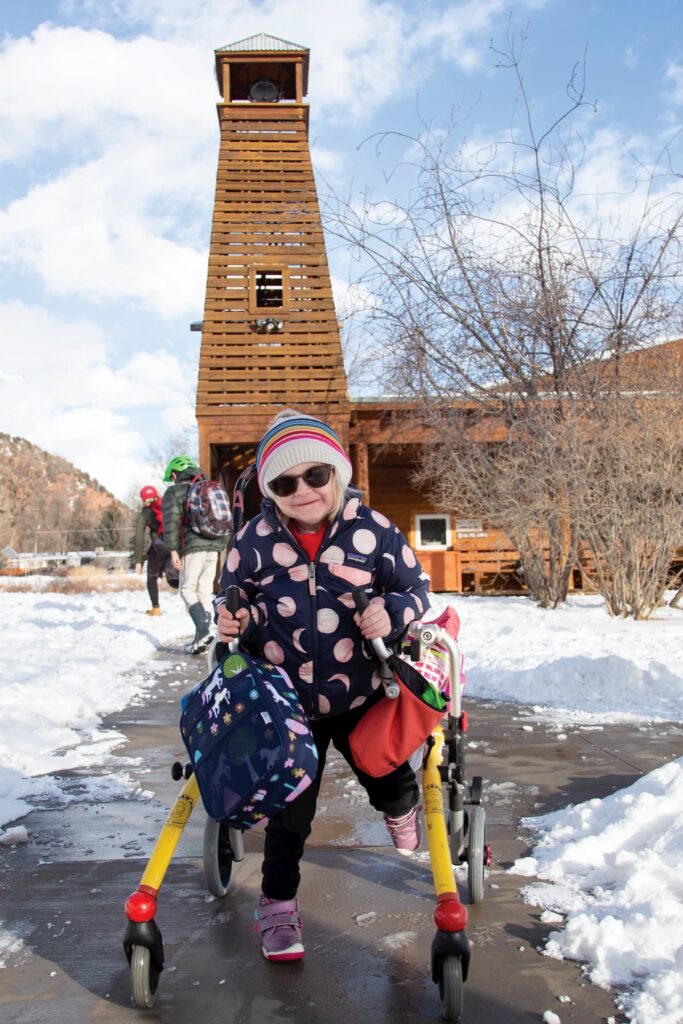
It takes a village.
I’ll say it. Parenting Addy is physically and emotionally demanding. We all need a break sometimes. We are blessed to have wonderful friends, a generous community and a great family support system here. Brent’s parents live here, and Addy and Jax love spending time with their Papa and Grandma. And my mom visits at least every few months. Just having those extra few hours to spend on “me time” or “our time” as a couple is time well spent.
My friends have played an important part in helping me through all of this. When they pull me aside at a party or at school pick up to give me a hug or ask how I am doing, I know I am loved and that I will get through this. It is through their kind and supportive words that I can shift my day from “I’m not going to make it” or “I can’t deal with Addy’s squirming and whining” to “Yeah, I can do this. Life goes on even after the worst thing happens.”
Our New Normal
I’m often asked what’s it like on a daily basis just get through the day. That’s a tough question to answer, because every day brings something new, whether it’s a family thing, or something that’s needed for an upcoming appointment, school, paperwork, doctor or therapy visit. What I can say is this – now, I am able to talk about our joys, challenges, and what it took to get where we are today. I get to share how Addy is thriving and living life to the fullest. No one could have felt more overwhelmed than we did – and now, here we are living our “new normal” life that seemed impossible three years ago. It’s never easy, it’s never what’s expected, but it is our life as a family and we continue to live it to its full potential every day.
One big shift is that I have found more time for “me.” I have started working out, seeing a therapist, going to breakfast with friends and spending some 1-on-1 time with Jax, Brent, and Oly. I ignored my own well being for a long time. From the beginning of Addy’s diagnosis, my friends, family, and others gave me lots of wise advice about self-care. But I was in “go mode,” focused on Addy and Jax, just getting through. Not taking care of “me” was not the smartest move, and I feel fortunate to have so many people ready to catch me when I fall, there to pick me up and listen. Brent has found his personal wellness groove as well, and it allows him to deal with the everyday stresses of life. We both understand that if we aren’t strong for the children, then we can’t be the best we can be as parents.
Ever since Addy’s diagnosis the kids, Oly, and I spend the summers in Powers Lake, Wisconsin, which is about an hour from Chicago where I grew up. The Lake is where I can reflect, recharge, and relax. I think the kids do too. Brent visits when he can get away from work. We have a ton of family support there, plus plenty of friends for Jax and Addy. I leave the lake each August, a little lighter and ready to face “real-life” back in Colorado.
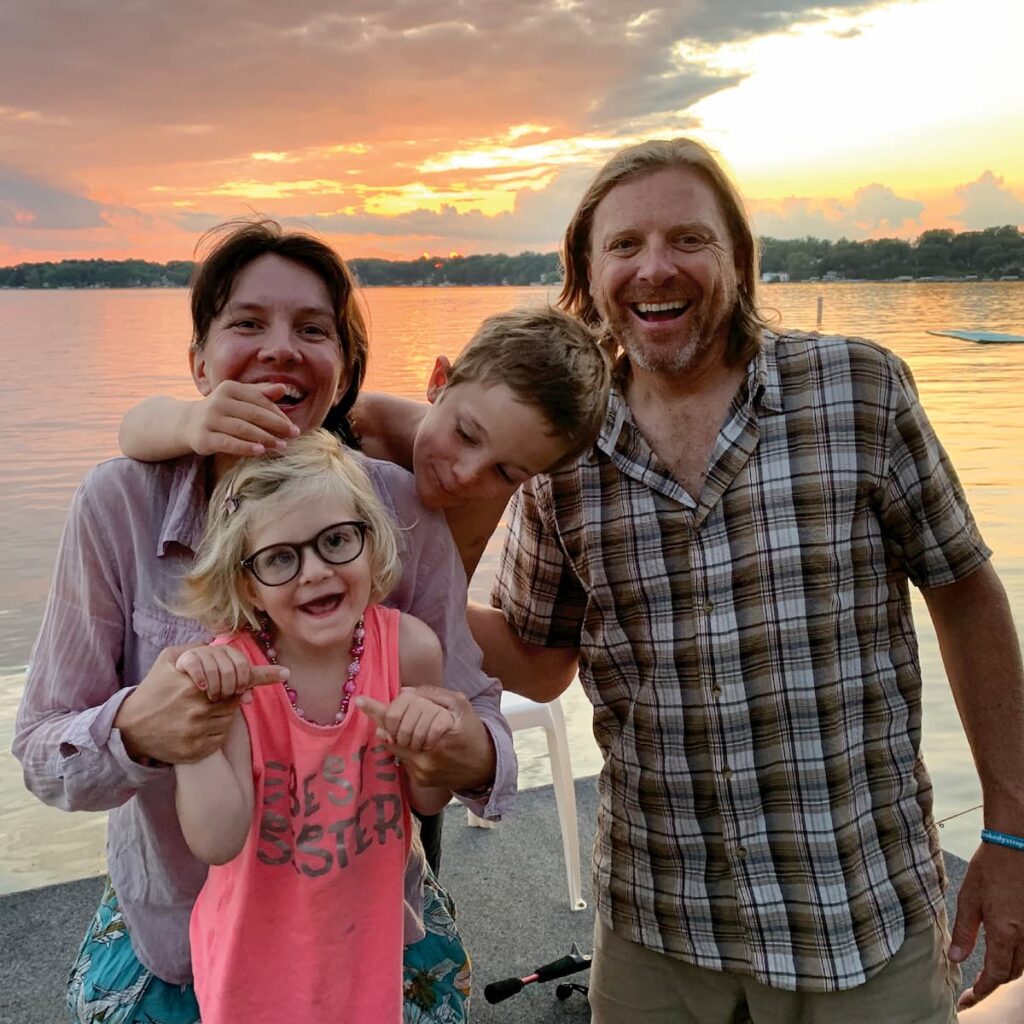
Our Superhero
Addy is a superhero even without wearing a special superhero suit or having a rare disease. She’s growing by leaps and bounds and learning new things all the time. Here’s her latest superpower: after sleeping with us for five years, Addy now sleeps in her own bed. She shares a room with Jax and they both love it.
Speaking of heroes, Jax has never asked what’s wrong or what’s different about Addy. He’s just accepting of who his sister is, and he loves and treats her with respect, love, and care – with the occasional brother-sister fight (which can feel refreshingly “normal!”)
Each May, I relive every little detail of that first phone call. No one expects to find out that their child has a rare and devastating disease. When I look back, it feels like I was dying and in a sense I was. With leukodystrophy, there are so many unknowns. How long will Addy be mobile? How long will she be able to enjoy parties and events? And even how long she will be with us on this earth? There are no answers, so as her biggest advocates, Brent and I feel our mission is to give our little angel a life of happiness and love that she deserves. We are her world – we’ll do whatever it takes to ensure happiness in her lifetime.
I try not to get stuck in the grief, sadness, and overwhelming nature of caring for a child that needs so much. Instead, I try to focus on the positives that have unfolded since that day, and how far our little girl has come. She’s truly an amazing person. She works harder than anyone I know. We’re blessed to have her in our lives, and she makes us better human beings. In a way, I like to think that Addy might turn me into a Superhero too.
a short memoir by
Jen Moss
Jen is a freelance graphic designer based in Carbondale. She has always loved the outdoors and now she gets to share that love of art and nature with her two children. In her free time, she loves to ski with her husband Brent and take winter walks along snowy paths with her dog Oly. She is the author of our Wellness feature, “Learning to Soar with My Superhero,” about how she has redefined healthy after learning of her daughter Addy’s Leukodystrophy diagnosis. This article began with our wish to learn about Jen’s push to create more handicapped accessibility in our community’s parks. We soon realized that her journey toward answers was where we needed to begin. We hope to follow her work on park-access in future editions.
with her mother
Claudette Collier
Claudette is the loving mother and grandmother behind the scenes of our Wellness feature, “Learning to Soar with my Superhero.” Formerly a Senior Manager of Global Learning Strategy and Operations, and Human Resources Manager, she’s recently retired and enjoying spending time with her beautiful family. Along with a busy family life, she is a proud member of the Board of Director’s for the United Leukodystrophy Foundation; an organization dedicated to finding cures for all Leukodystrophies.
photography by
Brent Moss
Born and raised in Minnesota, and drawn to the mountains like a skier to the powder, Brent has called Carbondale his home – and home base for outdoor adventure – for 23 years and counting. Adventure of a different kind is what he got when he started a family and, with his daughter Adele, discovered that life can hit you with anything, and was reminded how nature loves her little surprises… His family photos in our Wellness section prove the saying that the best shots happen when the subject is unaware of the camera. His natural ease with his craft comes through in these images – as does his love for his wife and children.
